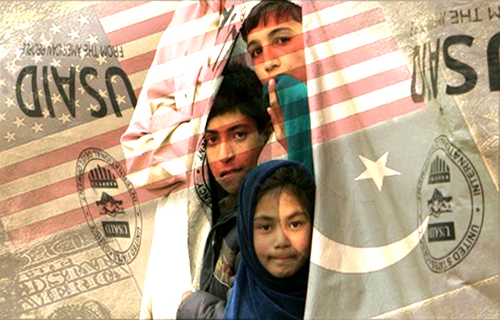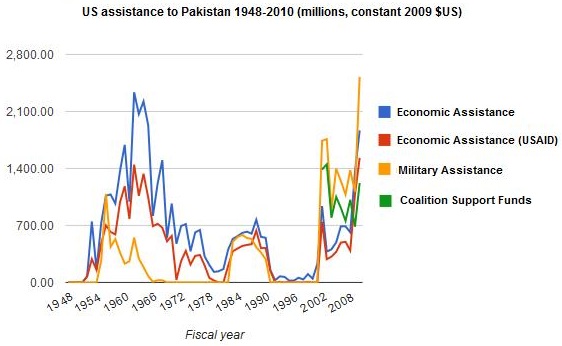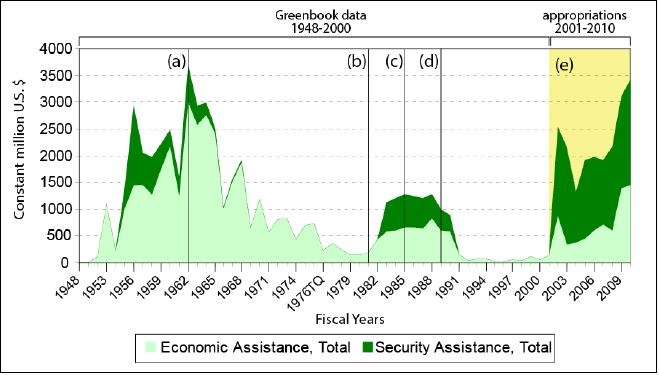U.S. Aid to Pakistan: Effectiveness and Challenges
IRIA Report - November 2014
Abstract:
Historically Pakistan has been among the top recipients of the US aid and assistance. Within last six decades, the US has sent more than 45 billion dollars in direct aid to the country. Nearly half of this has been for military assistance. However, since Osama bin Laden was discovered and killed in Abbottabad, the U.S. president Barack Obama has come under increasing pressure to justify the US aid spending in the Pakistan. This report analyzes the history of United States aid, its main interests in Pakistan as well as the challenges faced in the country. The focus will be the military aid by the U.S. spent in Pakistan and why the U.S. continue its support to Pakistan, even though both the countries have very complex relations
Introduction
Pakistan is arguably one of the most important countries which is promoting the United States interest in the region. But in order to accomplish their own objectives both the countries have their own policies and approaches, while the people who truly deserve foreign aid and assistance are suffering from such self-interested policies.
This report analyzes the effectiveness of USAID to Pakistan as well as the challenges faced by the United States. Moreover the report sheds light into the main interest for the United States for providing assistance and aid to Pakistan, reviews the difficulties faced by both the U.S. and Pakistan, and conflict of interest in this intricate relationship between the two countries. Thus the main argument raised in this report is, 'If both the U.S. and Pakistan have complex relations and trust issues, then why the United States of America continue its aid and support to Pakistan?'
In order to clarify these issues several articles and research papers have been reviewed and different approaches and perceptions from both the American and Pakistani sides have been considered.

The History of U.S. AID to Pakistan
U.S. aid to Pakistan has a long history and within different time span U.S. flowed aid into Pakistan for several projects, ranging from economic development and humanitarian aid to military and defense support. Soon after it’s' independence in 1947, Pakistan faced severe threats from India and was suffering from terrible economic conditions, thus had no other choice but to seek the U.S. help, and to ensure its survival. In the 1950s and 1960s, by joining two regional defense pacts, the Southeast Asia Treaty Organization and the Central Treaty Organization and signing military and other pacts of cooperation with the United States, Pakistan started receiving huge amount of aid from the West. Afterwards, through the United States Agency for International Development (USAID), USA started the flow of aid to Pakistan, which not only helped Pakistan develop its military but also played a vital role in development projects, food support and humanitarian assistance. By 1964, overall aid and assistance to Pakistan was around 5 percent of its GDP and with GDP growth rates rising to as much as 7 percent per annum Pakistan began its industrialization and development course.(1)
After the 1979 Soviet invasion of Afghanistan, the U.S. increased its aid and military assistance to Pakistan. Large amount of money and arms were channeled to the mujahedeen fighting the Soviet Army in Afghanistan through Pakistan's military and its clandestine agencies. Despite the U.S. continuous claims that the aid given to Pakistan during the Cold War period was not meant directly for Pakistan's military, there are plenty of evidence that those funds for the Afghan mujahedeen were pocketed by Pakistani officers.(2)
Consequently, during the Cold War period, United States considered Pakistan as an important ally and a hedge against the Soviet expansionism in the region; while on the other hand, Pakistan hoped to benefit itself from the U.S. geopolitical support, as well as financial and military assistance.(3)
After the end of Cold War, the U.S. aid to Pakistan was cut down to low levels, this significant reduction in aid was due to disengagement from Pakistan and Afghanistan after the defeat of the Soviet Union. And despite Pakistan's continuous request, United States neglected the problems in Afghanistan and totally abandoned the region and this action of the U.S. left many Pakistanis with the sense that they had been used and ditched.(4) Consequently, the abandonment of the region by USA set the stage for the era of terrorism.
Post 9/11 Scenario
The events of September 11 dramatically complete the change in the nature of U.S. aid to Pakistan from developmental aid, to purchasing Pakistan's cooperation in counterterrorism. While aid in the earlier decades - during the 1950s and 1960s - focused on helping the people of Pakistan and in supporting economic growth, aid in the 1980s in particular began to strengthen the military and its clandestine institutions, and soon after 9/11 it turned into mainly gaining Pakistan's support for defeating terrorists and fight against terrorism.
Twenty-five percent of total aid between 2001 and 2008 was allocated for economic and development assistance, including food aid. And some $5.8 billion of U.S. aid was spent on counter-terrorism and counter-insurgency activities in Pakistan.
U.S. Aid to Pakistan
USAID mission statement, states that the main purpose of the U.S. foreign aid towards Pakistan, as well as civilian-assistance program, is to develop a stable, secure and tolerant Pakistan with a vibrant economy. USAID has focused its program over the last year on five areas essential to Pakistan's stability and long-term development and reflective of Pakistani priorities: energy, economic growth, stabilization, education and health. USAID has streamlined the number of projects and has chosen to implement over half of all funding through local organizations in Pakistan (both government and non-government). Supporting the civilian government's capacity to meet the needs of its citizens is a vital element of USAID's program, as is working with non-governmental organizations and the private sector.(5)
However, S. Akbar Zaidi argues that both the U.S. and Pakistan has very different expectations from each other. Washington has accused the Pakistani government and military of duplicity, and of protecting key militant leaders living within Pakistan. The United States continues to ask the government of Pakistan to “do more.” While the Islamabad accused the United States for having dual-standards and involving in clandestine activities in its territory.(6)

Chart 1 show that the U.S. economic assistance to Pakistan was peaked in 1962, at over $2.3bn, and reached its lowest level in the 1990s, after President George H.W. Bush suspended aid flows over Pakistan's emerging nuclear programme. The U.S. military assistance also dropped dramatically during and immediately after the Indo-Pakistani wars of 1965 and 1971. The U.S. economic and military assistance to Pakistan has fluctuated considerably over the past 60 years, but it has risen steadily since 2001. In the year 2010 alone, the military assistance to Pakistan totaled $2.5bn.(7)
Therefore the only effective way to prevent future Al Qaeda attacks would be for the United States to take all its forces out of the Middle East. As far as the U.S. interest and security is concerned, the U.S. does not need to deploy ground forces in Afghanistan. The U.S. should form effective alliances with the regional countries, and in case of any serious crises it can rely on its’ military bases, and naval and air power in the region.
Therefore, to say that suicide terrorism is rational is to say that terrorists, like everyone else, have specific, “reasonable” goals that they wish to achieve through their actions; terroristic violence is, in this regard, an instrument or means to an end. They weigh the costs and benefits of many options and choose the “best” alternative. Indeed, for any terrorists organizations the suicide attacks can be one of the most effective “tools”. Many of the terrorists are made through political process, some organizations or actors turn to terrorism when they have exhausted by the non-violent means to achieve their goals.
Military Aid to Pakistan
After the 9/11 and the U.S. initiated war on terror in Afghanistan, President George W. Bush formally designated Pakistan as a major non-NATO U.S. ally and Washington started the major flow of security assistance to Islamabad for supporting the US-led anti-terrorism campaign, as well as its security and political interests in the region.
In 2002, the United States began allowing commercial sales that enabled Pakistan to refurbish at least part of its fleet of American-made F-16 fighter aircraft and, three years later, Washington announced that it would resume sales of new F-16 fighters to Pakistan after a 16-year hiatus. During the Bush Administration, a revived U.S.-Pakistan Defense Consultative Group sat for high-level discussions on military cooperation, security assistance, and anti-terrorism.(8)
But despite Pakistan's continues support to the United States and its operations in Afghanistan, the U.S. failed to fulfill its promises and did not deliver the latest modern electronic warfare systems, which was badly needed by the Pakistani army in war against Taliban.

Moreover, many Pakistani officials have continued to complain that U.S.-supplied defense equipment especially that most needed for counterinsurgency operations such as attack and utility helicopters has been too slow in coming. The Pakistani Ambassador to the United States has been quoted as claiming that, in his first two years in Washington, Pakistan received only eight used Mi-17 transport helicopters and that Pakistan’s military operations have been hindered by a lack of equipment.(9)
Chart 2 indicates that, although Pakistan has received military assistance from the U.S. during the early years, but after 9/11 there has been a significant increase in security and military assistance, which is in fact rising gradually.
The U.S. Strategic Interests and Challenges
United States Strategic Interests in the Region
The United States changing and blurred strategic interests in the region also create misconceptions and complexity in the U.S.-Pakistan bilateral relations, which further bring chaos and instability in the whole region. After reviewing several articles, the U.S. strategic interests in the region seems to be linked with the United States objectives in the Gulf region as well as in the whole Middle East.
The United States' aspiration to maintain its influence in the region, and achieve success in counter-terrorism war, as well as to counter emerging nuclear power Iran, the U.S. security and political measures can further justify the links with the Pakistan. Furthermore the road to Arabian Sea to Central Asia passes through Pakistan, so the U.S. in order to execute their long-term interests continues the flow of its aid and support to Pakistan.
At the same time, the U.S. has had close ties with Pakistan's arch-rival India. United States military agreements and increasingly close ties with India, as well as its continuous support for Indian nuclear program, have created apprehensions and doubts in Islamabad regarding the U.S. commitments and pledges to Pakistan. In fact, the United States have always allowed India to have an upper hand in the region and in order to gain that objective U.S. has always worked to pacify Pakistan rather than establish sincere relationship.
Challenges faced by the U.S.
The public opinion in the region is adversely against the U.S. policies, which include Washington's unipolar policy, approach towards Muslims and Arab world, and last but not the least, its continuous support to aggressive policies of Israel in Palestine and New Delhi's in Indian part of Kashmir.
With regard to the regional challenges, the U.S. is also facing a severe challenge in a fix balancing act to win the support of both the India and Pakistan, which often create questions in both Islamabad and New Delhi regarding the U.S. stance, its changing position and loyalty.
Moreover, after the Islamic Revolution in Iran and then occupation of Afghanistan, the U.S. is further faced by both the internal and external pressures. Internally, the U.S. government is facing challenges by their own population, who does not regard these problems as a major concern or threat to the U.S. interests. On the other hand, the U.S. is also facing external severe pressure from its own allies, especially in the Gulf.
Main Arguments and Analysis
In past years, the funds which were provided by the U.S. through USAID to Pakistan were designated for primary education, literacy programs, basic health, food aid, and support for democracy, governance, and elections. The United States provided economic, development, and humanitarian assistance to Pakistan through a number of funding accounts: the Economic Support Fund, Food for Peace, Global Health and Child Survival, as well as International Disaster Assistance, and Migration and Refugee Assistance. But today – especially sine 9/11 – more than 90 percent of total funds are directed toward military operations and very little percentage is directed toward development.
On one hand, the U.S. always emphasizes on democracy and transparency, especially regarding the aid matters. But on the other hand, there are clear evidence that the U.S. denied its support and aid assistance to Pakistan whenever their objects were accomplished or when they did not have any political and security interest, even though when the nature of government was democratic and transparent. Moreover, in order to fulfill their own objectives, the USA continued to support dictatorial regimes in Pakistan and facilitated the corrupt politicians to take over power in the country, which arouses many questions about the dual-standard policy of the United States, as well as marred the relations between the U.S. and Pakistan.
Conclusion
The U.S. aid to Pakistan in the post-9/11 era is no longer clear, and aid and development assistance lost its very purpose - of helping the people who are in need of aid - and became a political incentive.
Major aid flows during some periods and drastic cuts in others years - particularly when the U.S. suspended military assistance to Pakistan during the 1965 and 1971 war with its arch-rival India - created a perception among many Pakistanis that the United States is not a reliable ally and merely concerned about its own objectives. On the other hand, U.S. government views Pakistan as an unreliable partner in U.S. counterterrorism efforts, particularly after the 2011 revelation of Al Qaeda founder Osama bin Laden in a Pakistani city.
The United States accept the fact that it has given Pakistan military aid primarily to conduct military operations that support supposedly common counterterrorism interests in the region, and not only for development. But the Bush Administration concluded in late 2008 that Pakistan diverted much of the funds toward a military buildup focused on India, and thus the aid given to Pakistan was misspent.(9)
Therefore, the military, economic and humanitarian aid should be separated and the U.S. should avoid giving pre-conditions, on the other hand Pakistan should also make mechanism to make the use of development and humanitarian aid more transparent and effective.
As all above mentioned arguments and analysis indicates that, taking all the challenges in mind, the U.S. does not have many options in the table, but to continue building a healthy and improving relation with Pakistan with the aim of fulfilling its objectives. In doing so the U.S. continues its aid and military assistance to Pakistan, regardless of trust and confidence issues.
On the other hand, Pakistan is a critical friend and ally to the United States and share goals of combating terrorism, firmly establishing democracy and rule of law, and promoting social and economic development in Pakistan. It is also in the interest of the United States to ensure a stable Pakistan, with a liberal, democratic government focused on development. Hence, a stable, developed and strong Pakistan would also be in the interest of the United States.
References:
(1) Viqar Ahmed and Rashid Amjad, “The Management of Pakistan's Economy 1947-82”, Karachi: Oxford University Press, 1984.
(2) Shuja Nawaz, “Crossed Swords: Pakistan, Its Army, and the Wars Within”, Karachi: Oxford University Press, 2008.
Husain Haqqani, “Pakistan: Between Mosque and Military”, Lahore: Vanguard, 2005.
(3) Parvez Hasan, “Pakistan's Economy at the Crossroads: Past Policies and Present Imperatives”, Karachi: Oxford University Press, 1998.
(4) Pakistani President Pervez Musharraf's Address at Royal United Services Institute, London, January 25, 2008. https://www.afghanistannewscenter.com/news/2008/january/jan262008.html#14
(5) USAID to Pakistan, Projects - Official website of USAID, https://transition.usaid.gov/pk/db/projects_list.html
(6) S. Akbar Zaidi, “Who Benefits From U.S. Aid to Pakistan?”, Carnegie Endowment for International Peace, September 21, 2011.
(7) Sixty years of US aid to Pakistan: Get the data - Guardian News, https://www.guardian.co.uk/global-development/poverty-matters/2011/jul/11/us-aid-to-pakistan, 11 July 2011.
(8) Susan B. Epstein and K. Alan Kronstadt, “Pakistan: U.S. Foreign Assistance”, Congressional Research Service, October 4, 2012.
(9) “Pakistan Wants Combat Copters,” Washington Times, June 16, 2010; author interviews with Pentagon officials.
(10) “Pakistani Military Misspent Up to 70% of American Aid”, Guardian News (London), February 28, 2008.

















